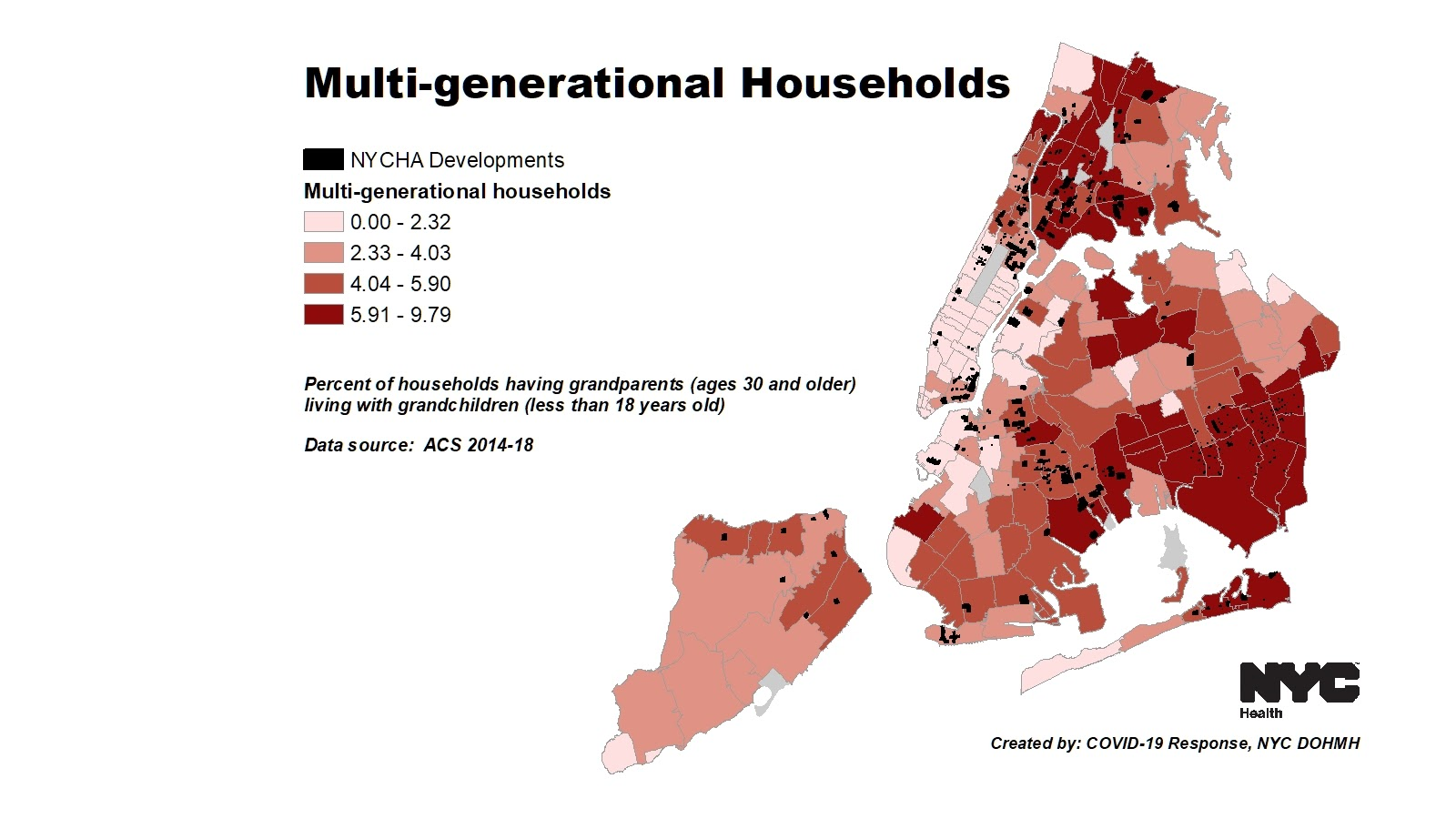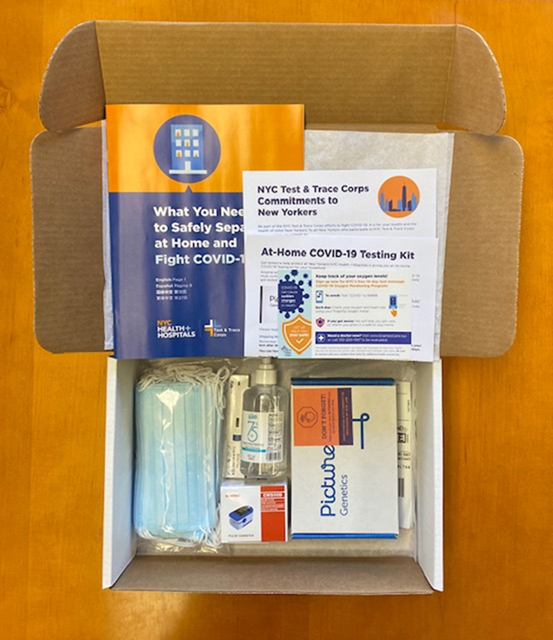With a population of over 8 million people, New York City contains varying degrees of household crowding. When mitigating the risk of household transmission of COVID-19, it is important to consider how household density can increase transmission.
A household can have many people living in one home, and sometimes many people sharing a single room. The zip code jurisdictions with the highest percentage range of people sharing a room (5.80%-15.74%) are concentrated in the outer boroughs such as Queens, Brooklyn, and the Bronx. Smaller crowding percentages are in Manhattan and Staten Island.

Households with multiple people may also be multi-generational. This means that many have extended family living under one roof, including grandparents who are 30 years of age and older living with their grandchildren who are less than 18 years old. The zip codes with the highest percentage of multi-generational households (5.91%-9.79%) are again in Queens, Brooklyn, and the Bronx.

With several people in one household or even sharing one room, the risk of transmission can increase. Members of each household may need resources to safely separate during an isolation or quarantine period.
NYC Test & Trace Corps – Take Care
The NYC Test & Trace Corps provides resources that ensure that anyone who tests positive for COVID-19 and their close contacts can separate at their home or at a hotel free of charge.
By working with Resource Navigators, the Test & Trace Corps can provide information and support to improve access to services, often local to the neighborhoods where our Cases and Contacts reside. Any Case or Contact can ask their Case Investigator or Monitor to refer them to a Resource Navigator who can connect them to the programs they need. Partner organizations include BronxWorks, the City University of New York, The Joan & Alan Bernikow Jewish Community Center of Staten Island, and the Chinese-American Planning Council.
In addition to connecting to community-based organizations, household members are given the option to ask for other free resources. These include, but are not limited to:
- Food delivery
- Paid leave from an employer
- Assistance obtaining a quarantine order (necessary to access paid leave)
- Medication delivery, including methadone
- Health insurance
- Utilities coverage (electricity, gas, water)
- Primary care provider
- Mental health support
- Help with domestic violence
- Social services
- Housing and homelessness resources
- Pet care
A few of the most requested services are food delivery, social services, health insurance and medication delivery, and assistance in asking for paid leave from an employer.
The Corps works with GetFoodNYC for food delivery and has provided over 200 million meals to New Yorkers over the course of the pandemic. Resource Navigators also assist in traversing the process of Paid Sick Leave to help provide a source of income while being COVID-19 positive or quarantined.

The Take Care Package contains enough personal protective equipment for a household of three to quarantine or isolate for 10 days. Cases and contacts are asked whether they’d like a Take Care Package and to verify their address when they complete their intake interview.
Safely Separate at Home
If a positive Case or their close Contact decides they want to separate at their own home, the NYC Test & Trace Corps provides them with meals, medication delivery, or other social services on top of equipment for daily health monitoring of COVID-19 symptoms in their Take Care Packages. They will also continue to receive monitoring calls or SMS text messages through Contact Tracing.

A Take Care Package includes medical grade masks, hand sanitizer, thermometers, a pulse oximeter to help those who test positive for COVID-19 monitor oxygen levels, and an at-home testing kit. As of March 31st, 2021 about 272,603 care packages have been delivered so far.
Emergency Financial Assistance
Emergency Financial Assistance is available to certain cases and contacts who demonstrate unmet need such as a lack of groceries, or assistance in paying for rent or utilities. This can be inferred if they report a loss of income or increased expenses due to isolation or quarantine.
Other eligibility requirements include that a client cannot take advantage of Paid Sick Leave and be <200% of the supplemental poverty measure. Eligible clients are referred for emergency financial assistance.
Safely Separate in a Take Care Hotel
If a case or contact lives in a household with more than one person or shares a room with someone, they are encouraged to separate outside of their home. Staying in a Take Care Hotel is an option for those who decide to do so, and they can stay for free for up to 10 days.
From the time that the program started on June 1st, 2020 through March 31st, 2021 Take Care Hotels have had 16,824 guests and provide a convenient method of protecting other household members.
Hotel guests have access to additional free services. These include:
- Round-trip transportation to and from the hotel and any essential medical appointments, such dialysis
- Private rooms and bathrooms
- Onsite COVID-19 testing for contacts
- Wi-Fi and unlimited local phone calls
- Three meals a day and snacks
- Medication delivery, including methadone
- Onsite clinical support and monitoring, including pulse oximetry
- Telepsychiatry
Interventions for Household Transmission
One of the most common risk factors of transmission of COVID-19 is living in a household with multiple individuals. The infectious period in a positive case is the greatest starting about two days before symptom onset and continuing to the following week. Even if a case is asymptomatic and does not show any symptoms, it is critical that prevention measures are met when exposure is suspected as soon as possible.
Whether it is through following prevention guidelines such as wearing a mask around others, maintaining social distancing, using separate rooms or bathrooms, and practicing good hand hygiene, other resources can be considered when separating at home is not possible.